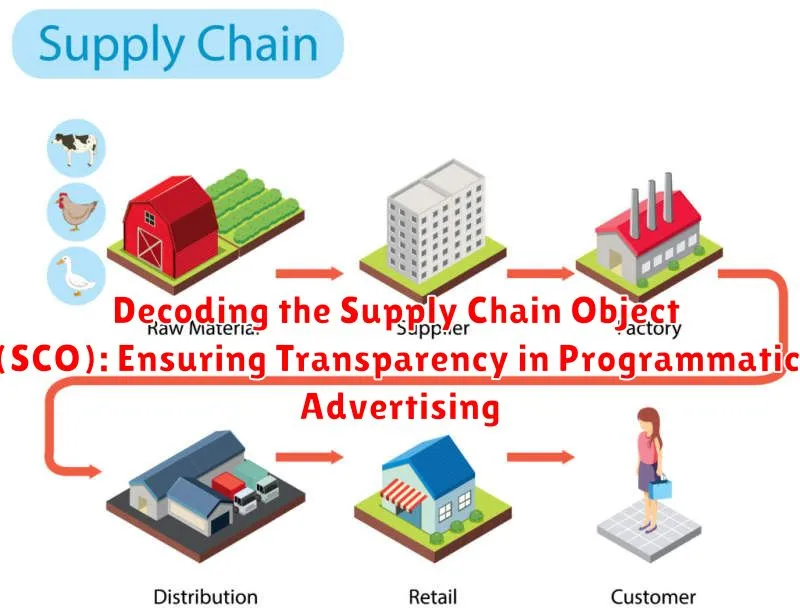In the increasingly complex landscape of programmatic advertising, maintaining transparency and accountability is paramount. The Supply Chain Object (SCO) emerges as a critical component in achieving this goal. This article, “Decoding the Supply Chain Object (SCO): Ensuring Transparency in Programmatic Advertising,” delves into the intricacies of the SCO, exploring its structure, function, and significance in fostering trust within the digital advertising ecosystem. We aim to demystify the SCO and provide a comprehensive understanding of how it contributes to a more transparent and verifiable supply chain for all stakeholders, from advertisers to publishers.
The need for transparency in programmatic advertising stems from concerns surrounding ad fraud, brand safety, and the overall efficiency of media buys. The SCO, standardized by the IAB Tech Lab, offers a mechanism to trace the path of an ad impression from its origin to the end user. This article will break down the technical aspects of the SCO, explaining how it works in practice and highlighting the benefits it offers. By understanding the Supply Chain Object, industry professionals can better navigate the complexities of programmatic, ensuring their campaigns are effective, ethical, and deliver measurable results. We will also discuss the challenges and opportunities associated with widespread adoption of the SCO, paving the way for a more accountable and trustworthy digital advertising future.
What is the Supply Chain Object (SCO) in Programmatic Advertising?
The Supply Chain Object (SCO) is a standardized data structure within the programmatic advertising ecosystem. Its primary purpose is to provide transparency regarding the path an ad request takes from the publisher to the eventual buyer.
Think of it as a digital receipt or provenance record. It meticulously documents each entity or “node” involved in the sale of ad inventory. This includes the publisher, any intermediaries such as Supply-Side Platforms (SSPs), exchanges, and other resellers.
By encoding this information, the SCO allows buyers to verify the legitimacy and origin of the inventory they are purchasing, fostering greater trust and accountability within the complex programmatic supply chain.
The Importance of Transparency in Programmatic Advertising
Transparency in programmatic advertising is crucial for fostering trust and accountability between advertisers, publishers, and consumers. Without clear visibility into the ad supply chain, stakeholders are vulnerable to fraud, inefficiencies, and wasted ad spend.
A lack of transparency can lead to:
- Hidden costs and fees: Unknown intermediaries can inflate prices.
- Misappropriation of ad spend: Budget may not reach intended publishers.
- Decreased brand safety: Ads can appear on inappropriate or harmful websites.
- Compromised data privacy: User data may be misused without consent.
Therefore, increased transparency is essential for a healthier and more effective programmatic ecosystem. It empowers advertisers to make informed decisions, ensures publishers are fairly compensated, and protects consumers from malicious practices. Initiatives like the Supply Chain Object (SCO) play a vital role in achieving this goal.
How the SCO Enhances Transparency and Accountability

The Supply Chain Object (SCO) significantly enhances transparency and accountability within the programmatic advertising ecosystem by providing a verifiable record of the chain of entities involved in an ad transaction. This allows advertisers to trace the path of their ad spend, ensuring that it reaches the intended publisher and reduces the risk of fraudulent activities.
By offering a clear lineage of each participant, the SCO fosters greater trust among advertisers, publishers, and intermediaries. This verifiable audit trail holds each entity accountable for their role in the supply chain, promoting ethical practices and responsible ad spending.
Here’s how the SCO contributes to enhanced transparency and accountability:
- Visibility: Advertisers gain clear visibility into the intermediaries involved in the transaction.
- Verification: The SCO allows verification of the legitimacy of each entity in the chain.
- Fraud Reduction: Increased transparency helps identify and mitigate fraudulent activities, such as domain spoofing and impression laundering.
- Accountability: Each participant is accountable for their actions within the supply chain.
Key Components of the Supply Chain Object (SCO)
The Supply Chain Object (SCO) is composed of several crucial elements that work together to trace the path of an ad request through the programmatic ecosystem. Understanding these components is essential for interpreting the data and verifying transparency.
- Nodes (SupplyChainNode Objects): Each node represents a distinct entity involved in the ad transaction, such as publishers, intermediaries, or ad exchanges. Each node contains information about the entity.
- hop_limit: Indicates the maximum number of intermediary hops allowed in the supply chain.
- ver: Specifies the version of the SCO specification being used.
- ext: Allows for custom extensions to include additional information specific to the implementation or participating entities.
Each SupplyChainNode includes fields like:
- asi: The Ad System Identifier, uniquely identifying the entity within the ad tech ecosystem.
- sid: Seller ID, identifying the seller within the context of the Ad System.
- rid: Request ID, a unique identifier for the specific ad request.
- name: A human-readable name for the entity.
- hp: Represents the payment flow, indicating whether the entity is directly paying (1) or passing through payment (0).
Benefits of Implementing the SCO for Advertisers and Publishers
The implementation of the Supply Chain Object (SCO) offers significant advantages for both advertisers and publishers within the programmatic advertising ecosystem. For advertisers, the SCO provides enhanced transparency into the ad supply chain, allowing them to verify the legitimacy of inventory sources and ensure that their ad spend is reaching genuine audiences. This increased visibility helps in reducing the risk of ad fraud and improves the overall effectiveness of campaigns.
Publishers benefit from the SCO through its ability to demonstrate the quality and origin of their inventory. By clearly showcasing their position in the supply chain, publishers can attract higher bids from advertisers seeking trustworthy and transparent partnerships. This can lead to increased revenue and stronger relationships with advertising partners.
In summary, the SCO fosters a more trustworthy and efficient programmatic ecosystem, benefiting all stakeholders involved.
Challenges and Considerations When Using the SCO
While the Supply Chain Object (SCO) offers significant benefits for transparency in programmatic advertising, its implementation also presents several challenges and considerations. One key challenge is the complexity involved in accurately capturing and transmitting supply chain data across various platforms and intermediaries. This requires careful coordination and standardization across the ecosystem.
Data volume can also be a concern. The SCO can generate a substantial amount of data, which requires sufficient infrastructure to store, process, and analyze effectively. This can pose a challenge for smaller organizations or those with limited technical resources.
Another significant consideration is the potential for latency. Adding the SCO to ad requests can increase the size of the request and the processing time, potentially impacting page load times and user experience. Careful optimization is necessary to mitigate this risk.
Finally, adoption rates across the industry are crucial. The SCO is most effective when widely adopted, but achieving universal adoption can be difficult due to varying levels of technical capabilities and willingness among different players in the programmatic ecosystem. Overcoming these adoption hurdles is vital for realizing the full potential of the SCO.
The Role of the SCO in Combating Ad Fraud
Ad fraud remains a significant concern in programmatic advertising, costing the industry billions annually. The Supply Chain Object (SCO) plays a crucial role in mitigating this threat by providing a clear and auditable trail of the parties involved in the ad transaction. This transparency makes it more difficult for malicious actors to inject fraudulent impressions or manipulate the supply chain.
By verifying the legitimacy of each entity involved, the SCO helps to ensure that advertisers are paying for genuine impressions served to real users. This reduces the risk of wasted ad spend and improves the overall effectiveness of programmatic campaigns. The presence of a complete and verifiable SCO signals a higher level of trustworthiness, deterring fraudulent activities.
Here’s a simplified view of how SCO aids in fraud detection:
- Verification: Allows for verification of each entity’s legitimacy.
- Transparency: Exposes intermediaries that might be involved in fraudulent practices.
- Accountability: Holds each participant accountable for their role in the supply chain.
SCO Implementation: A Step-by-Step Guide
Implementing the Supply Chain Object (SCO) requires a systematic approach to ensure accurate and effective data transmission. This guide outlines the essential steps for integrating the SCO into your programmatic advertising workflow.
Step 1: Audit and Mapping
Begin by auditing your existing supply chain. Map all participants, including publishers, intermediaries (SSPs, ad exchanges), and advertisers (DSPs). Understand the data flow between each entity.
Step 2: Technical Integration
Integrate the SCO into your ad requests. This involves updating your systems to generate and pass the schain parameter with each bid request. Ensure your technical team is familiar with the IAB Tech Lab’s specifications.
Step 3: Validation and Testing
Thoroughly test your implementation. Use validation tools to verify the correctness and completeness of the SCO data. Monitor for any errors or inconsistencies.
Step 4: Monitoring and Optimization
Continuously monitor the performance of your SCO implementation. Analyze the data to identify areas for optimization and improvement. Stay updated with industry best practices and evolving standards.
The Future of the SCO: Evolving Standards and Practices

The Supply Chain Object (SCO) is not a static entity; its future hinges on continuous evolution and adaptation to the dynamic landscape of programmatic advertising. Expect to see ongoing refinement of the IAB Tech Lab’s specifications, driven by industry feedback and the emergence of new challenges.
One key area of development will likely be the expansion of the SCO to incorporate a wider range of participants and transaction types. This may include support for emerging channels, such as connected television (CTV) and digital out-of-home (DOOH), as well as more granular details about data usage and consent management.
Further standardization efforts will be crucial to ensure interoperability across different platforms and technologies. Standardized methods for SCO validation and error handling will enhance the efficiency and reliability of the ecosystem.
Ultimately, the goal is to make the SCO a ubiquitous and indispensable component of programmatic advertising, fostering greater trust and accountability for all stakeholders. The industry must actively participate in shaping the future of the SCO to maximize its potential benefits.
SCO and Data Privacy: Ensuring Compliance with Regulations
The Supply Chain Object (SCO) plays a vital role in navigating the complex landscape of data privacy within programmatic advertising. As regulations like GDPR and CCPA become increasingly stringent, the SCO offers a mechanism for ensuring compliance by providing a clear audit trail of data flow.
Here’s how the SCO aids in data privacy compliance:
- Transparency in Data Handling: The SCO illuminates which entities have handled user data during the ad transaction process.
- Consent Tracking: It can be used to signal consent information across the supply chain, ensuring that data processing aligns with user preferences.
- Accountability: By identifying each participant in the data flow, the SCO enhances accountability and simplifies the process of addressing data privacy concerns.
Implementing the SCO is a crucial step toward responsible data practices in programmatic advertising. It helps ensure that personal data is handled lawfully, transparently, and in accordance with applicable regulations.

